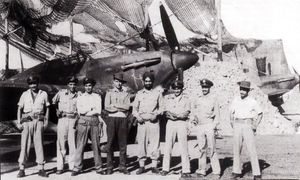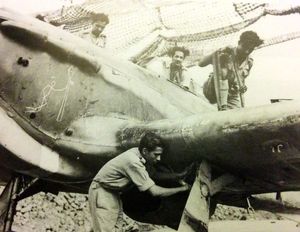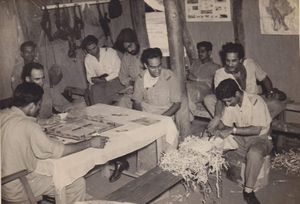March
Before the Japanese offensive against Imphal started on 8 March, the aerial operations were directed towards the lines of communication near the Chindwin. No.1 Squadron did recce sorties to bring back information on state of bridges, serviceability of roads, usage of these roads etc along with any tell-tale signs of supply caravans, including elephants and cattle. With hindsight, this information should have pointed out the intentions of the Japanese plans. But at that time it was thought that the offensive was still months away.
The First loss : On 8 March, the squadron suffered its first casualty.
A six Hurricane sweep by Sqn Ldr Arjan Singh., with Hafeez, Murcott, Kaisrani, Kapur and Roy took off at 10.45 hours. Somewhere along the sortie, Kaisrani’s Hurricane (BG739) dropped out of sight. It was suspected he went down due to a glycol leak. He was never found. Muhammad Nawas Kaisrani (1815/IND), hailed from Dera Ghazi Khan. He is commemorated on the Singapore CWGC Memorial. . This was the only loss during the first two months of the squadron’s operations. No Japanese aircraft was encountered during this period.
This did not deter the squadron. It kept up the tempo of flying more than a dozen sorties every day .
From 9 March reconnaissance over the areas through which the Japanese were advancing was the principal task. The Japanese were then trying to cut off the 17th Indian Division by establishing road blocks on the Tiddim road along which it was retreating to Imphal. No. 1 Squadron’s task was to locate the position of the retreating troopsand of mechanical transport from day to day, drop mail near the divisional headquarters at milestone 126 and keep an eye on the tracks leading from the Tiddim road for signs of Japanese movement.
Special attention was paid to the Japanese advance to the north east of Imphal, where two divisions were taking part. The fighting was very confused and positions of allied positions were not very clear. Effort was placed towards identifying the pace of the Japanese advance.
On 13 March, when Imphal, Kohima and Dimapur were in peril from the Japanese assault, Mountbatten and General Slim had a crucial meeting with Air Marshal Baldwin who commanded Third Tactical Air Force. In view of the crisis in Imphal, Baldwin and Slim supported Mountbatten who, far exceeding his authority, transferred 30 Dakotas from The Hump forces, in order to fly 5th Indian Division from the Arakan to bring reinforcement to the defences of Imphal.
The Imphal valley saw the first air offensives by the Japanese air forces in mid-March. On March 16th, Tulihal airfield was attacked but a Beaufighter of 176 squadron shot down one of the raiders – a Mitsubishi Sally bomber.
On 17 March, 100 loaded mules and some troops were seen on the road to Minthami Chaung. The aircraft resisted the temptation of mounting an immediate attack. They sent a report which brought bombers to the target.
More pilots joined the Squadron in March. Flying Officer A R Pandit was one such pilot who had been left behind at Kohat. He was able to catch up with them in Imphal. His tour did not start well. On his very first sortie on March 21st , Pandit had a tyre burst on take off in Hurricane HM139. He belly landed at Tulihal with his undercarriage retracted.
On March 24th, Six Hurricanes from the squadron strafed Japanese gun positions east of Sangshak., about eight miles south-west of Ukhrul. This was the same area that the Indian Para Brigade took part in trying to hold the Japanese. The day was also significant in WW2 History – This was the day that the B-25 carrying Brigadier Orde Wingate, the Commander of the Chindits, took off from Imphal and soon after crashed in bad weather west of the valley.
The 10 Aircraft Raid:
29th March was a significant day in the operations of the squadron. On the ground, the Imphal-Dimapur road was cut at milestone 107. Several offensive sorties were flown by the squadron throughout the day.
One such sortie was by Flt Lt Raza and Flying Officer F P Amber in the Fort Krary area. They found a convoy and strafed it, setting several vehicles on fire. Japanese troops scattered in all directions. Both pilots exhausted their ammunition and came back to base. Another mission was flown by Murcott and Bulsara at 1620 Hours. They strafed several enemy positions before returning.
The squadron thought that the day was over, but that turned out to be premature. At 1800 hours, an urgent call for close air support came to Imphal main. All available Hurricanes were ordered to take off and head for the area North of Imphal to attack masses of Japanese troops. This was in the vicinity of Pukhao village, around 22 miles west of Shangshak.
All available pilots of four Hurricane squadrons, 28, 34, 42 and No.1 IAF ran to their aircraft and took off. A total of 33 Hurricanes soon headed for the target. Ten of these were from No.1 Squadron – led by Arjan Singh, consisting of R Rajaram, Hafeez, B R Rao, T A M Andrade, N R C Murcott, Prabhakar, H Raza, F P Amber and Bulsara. Navigating with maps in poor light, the Hurricanes attacked the Japanese troops at the reported villages. There was return fire by small arms from the troops on the ground from all sides. All the ten Hurricanes landed back safely in the dark skies by 18.30 hours. 12760 rounds of .303 ammunition were expended by the ten Hurricanes. The attack was deemed succesful. Captured Japanese documents later revealed that the combined strike on Pukhao had cost the Japanese 14 officers and 217 men in killed and wounded.
The squadron flew 366 sorties totalling about 530 hour in March.
|
B Flight – L to R : F P Amber , K N Kak, M M A Cheema, H Raza (Flt Cdr), Rajendra Singh, AM Kapur, U/I, M N Bulsara |
|
Left to Right: Unidentified, Flt Lt Raza (Board Game), Unidentified Sgt, Fg Offr M M A Cheema, Fg Offr Rajendra Singh, Fg Offr AM Kapur, Unidentified, Fg Offr F P Amber (Rear), Fg Offr M N Bulsara (Opening Package) |
|
B Flight Crew Room at Imphal – Circa 1944. Left to Right: Unidentified, Flt Lt Raza (Board Game), Unidentified Sgt, Fg Offr M M A Cheema, Fg Offr Rajendra Singh, Fg Offr AM Kapur, Unidentified, Fg Offr F P Amber (Rear), Fg Offr M N Bulsara (Opening Package) |
April
In April the Allied troops were fighting at Imphal with their back to the wall. The Japanese came so close that the Imphal airfield came within the range of Japanese artillery fire for a brief period. Air operations were carried out to the maximum extent and No. 1 Squadron flew 412 sorties totalling 485 hours in April. Reconnaissance of the Japanese lines of communication was the main task. Tiddim road, Palel-Tamu-Sittaung road, Imphal-Kohima road and the Ukhrul area were constantly visited. In the course of their work the squadron pilots brought information regarding the condition of the roads and bridges in these areas, the movement and position of Indian and Japanese troops, besides carrying out search for evidence of Japanese infiltration. A large number of strafing attacks were made against bashas, mechanical transports, reported gun positions and troops.
Another Pilot MIA:
On 4 April two Hurricanes, flown by Fg Offr N R C Murcott and Fg Offr M N Bulsara were out on a tactical reconnaissance of the Tamu road. They spotted a Japanese tank near Minthami and immediately attacked it. During the attack Bulsara noticed a flash from the target. While taking evasive action his aircraft flew close to a tree and its wingtip was damaged. Bulsara radioed that he was turning for base and Murcott acknowledged the call. Bulsara returned to force-land at Palel airfield. Murcott continued to attack but that was the last anyone heard about him. The reason of his failure to return could not be ascertained but the flash from the target seems to suggest that the tank might have been a trap for decoying unwary aircraft. Noel Ruxton Clarke Murcott (1717/IND) was just 22 years old, hailing from Calcutta. He has no known resting place and is commemorated on the Singapore Memorial.
4th April was also notable for the fact that the Imphal main airfield was shelled for the first time. The pilots of No.1 Squadron flew their Hurricanes out to Tulihal airfield.
The Squadron was at the receiving end on the 15th of April, when a force of 9 Japanese bombers, escorted by about 40 fighters attacked the Imphal plane. Two Hurricanes of the Squadron were destroyed on the ground, and two airmen wounded. Operations continued unabated. But another loss was suffered on 27th April. Fg Offr Rajendra Singh and Plt Offr Augustine Roy (IND/2859) went on TaC/R mission of Lessami area. Roy failed to return as he went in too low shooting up a target at Ukhrul.
For the month of April, No.1 Squadron flew 412 Sorties totalling 485 Hours. Two pilots were lost – both missing believed killed.


